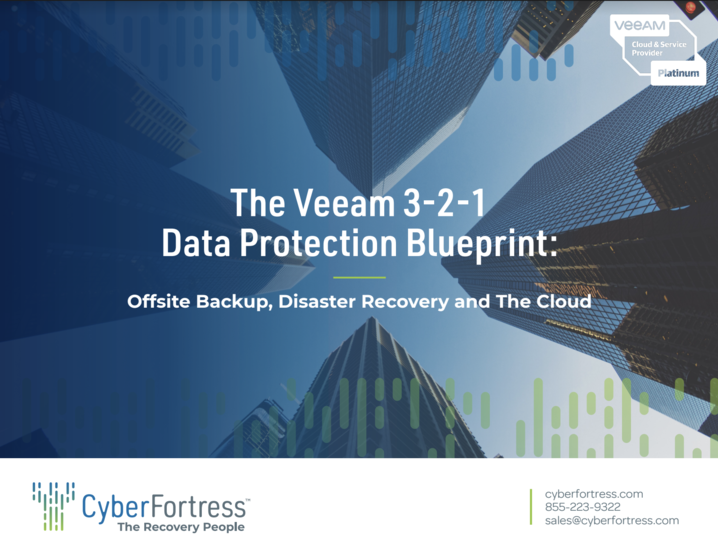Disaster Recovery Offsite Providers: Why is it Important?
Recovery is no problem for an internal IT team, so long as it involves just finding a deleted file or bringing back a single virtual machine (VM). Success depends on having the right backups in place, which can be accomplished with the right software and cloud storage.
But it’s a different ballgame when there’s a fire in your data center or a ransomware attack digitally shredded all your files. Are your backups in shape to be restored? Do you know where you’ll recover to? Can you get those mission-critical apps back online in minutes?
Disaster recovery (DR) is complex, involving lots of moving parts that must be synchronized. It all must be orchestrated under the eyes of a C-suite anxious to get the business running again. They have every reason to be concerned. After all, the Veeam Data Protection Report 2021 puts the hourly cost of downtime at $84,650 and the average events last around 79 minutes.
Time is money. The ability to respond quickly can save sales, customers, reputations, and even IT management careers.
Time for some SaaS?
You can set up backup jobs on your own. But with so much at stake, you may want a partner skilled not only in backup, but also in storage management, data optimization, retrieval and recovery. Companies have been enlisting cloud service providers (CSPs) in record numbers for software-as-a-service (SaaS) applications. According to analysts from Gartner, public cloud services will reach $304.9 billion in 2021, a $47.4 billion increase over 2020.
A backup-as-a-service and DR-as-a-service (BaaS and DRaaS) provider offers more than cloud backup storage. They design backup and disaster strategy, provide options for data tiers, ensure recovery point and time objects (RPOs and RTOs) with a service level agreement (SLA), monitor the data protection process end-to-end and deliver 24×7 support. If that original server or your entire data center goes down, they’ll be ready to mount your apps and data in their cloud or data center so you can get up and running.
Further, while even a veteran IT person may recover from one or two disasters in their career, BaaS and DRaaS is a CSPs business. It’s run by people with specific backup and DR experience. They will have performed more recoveries and failovers than even the strongest internal IT team. The right CSP will also have close relationships with product vendors in the space and staff certified on offerings. And, a strong service provider will have the latest and greatest technology and stay abreast of future advancements, relieving companies of significant investments and maintenance.
Selecting A DRAAS Provider
Any CSP knows the 3-2-1 rule, and they should be able to tack that zero to the end of it by eliminating any restore errors with backup testing. They should be able to guide you into services that cost-effectively address your organization’s needs. But that’s only table stakes, and with so many CSPs, how do you choose the right one?
Not only is there an updated 3-2-1-0 rule, Veeam offers up this new 3-2-1-1-0 version!

First, remember this is about your organization, so look for a CSP that fits your needs, not how you can fit into their offerings. To do that, we recommend developing a list of “must haves” to guide your search. The following are a few items to consider:
- Geography: If you have requirements regarding where data, systems and apps are to be hosted, make sure the CSP is aligned accordingly.
- Market: If you face compliance standards, be sure the CSP has experience helping with the regulations in your market.
- Hosting: Are you comfortable with your workloads stored in a public cloud? Do you need object storage, collocation, maybe the provider’s facilities? Iron out the hosting model up front.
- DR services: Backup and recovery go hand in hand, so even if you’re only exploring BaaS, be sure the CSP is equally skilled in DR – you may want to pursue this at a later time.
- Service levels: Be clear on what you require for performance, availability and recoverability. Require an SLA and identify if there’s any dependencies that may make meeting it difficult.
Choose a Disaster Recovery Provider You Trust
At CyberFortress, managing Veeam cloud backup and disaster recovery is what we do all day, every day. Our experts have created hundreds of backup plans and many disaster recovery failovers. We have very close relationships with innovators in the space such as Veeam Software; we know their proven offerings inside and out and have certifications to back it up.
If you run into any issues, you can trust our entire team of data protection veterans who have your back. And when you’re ready for other services, like DRaaS or Infrastructure as a Service (IaaS), we can take you there, too.
Trust is a must when it comes to finding a CSP, so be sure to do your due diligence, ask for references, and make sure they have the experience to do what they say and longevity that proves they’re in this for the long run.
How do you choose the right service provider? Download this checklist with 8 things to demand of your DRaaS solution from our latest e-book, “The CyberFortress 3-2-1 Data Protection Blueprint: Offsite Backup, Disaster Recovery & The Cloud”



